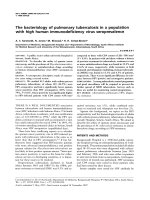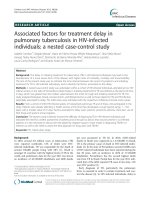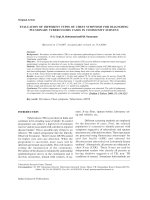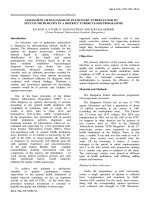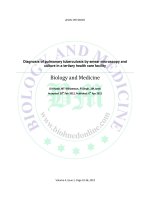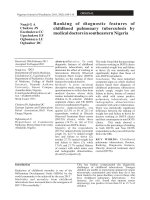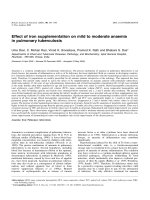Variation of Chest Radiographic Patterns in Pulmonary Tuberculosis by Degree of Human Immunodeficiency Virus–Related Immunosuppression pot
Bạn đang xem bản rút gọn của tài liệu. Xem và tải ngay bản đầy đủ của tài liệu tại đây (153.21 KB, 5 trang )
242
Variation of Chest Radiographic Patterns in Pulmonary Tuberculosis by Degree
of Human Immunodeficiency Virus–Related Immunosuppression
David C. Perlman, Wafaa M. El-Sadr, Eileen T. Nelson,
From the Division of Infectious Diseases, Beth Israel Medical Center,
and the Division of Infectious Diseases, Harlem Hospital Center, New
John P. Matts, Edward E. Telzak, Nadim Salomon,
York, New York; CPCRA Statistical Center, Coordinating Centers for
Keith Chirgwin, and Richard Hafner, for the Terry
Biometric Research, Division of Biostatistics, School of Public Health,
Beirn Community Programs for Clinical Research on
University of Minnesota, Minneapolis, Minnesota; Bronx-Lebanon
AIDS (CPCRA) and the AIDS Clinical Trials Group
Hospital Center, Bronx, New York; Division of Infectious Diseases,
(ACTG)
SUNY Health Science Center at Brooklyn, New York; and Division of
AIDS, National Institute of Allergy and Infectious Diseases,
Washington, D. C.
Our aim was to evaluate the effect of human immunodeficiency virus (HIV) disease stage on
chest radiographic (CXR) findings among patients with HIV-related pulmonary tuberculosis (TB).
Data are from a prospective multicenter treatment trial for HIV-related TB. Baseline CXR findings
and CD4
/
lymphocyte counts were compared among patients with HIV-related TB. Data from
published studies describing CXR findings in HIV-infected patients were reviewed and a pooled-
data analysis was conducted. Of 135 patients with culture-confirmed HIV-related TB, 128 had both
CXR and CD4
/
lymphocyte data. CD4
/
lymphocyte counts of õ200/mm
3
(n Å 98) were significantly
associated with hilar/mediastinal adenopathy on CXR (30%, vs. 7% with counts §200/mm
3
;
P Å .01); counts of §200/mm
3
(n Å 30) more frequently were associated with cavitation (20% vs.
7%; P Å .08). Analyses of these results, pooled with other published data, confirmed these findings.
This study demonstrates associations of certain CXR findings with HIV disease stage. Knowledge
of the degree of immunosuppression is important when evaluating CXR findings in HIV-infected
patients.
HIV is a potent risk factor for tuberculosis (TB), both this greater proportion of primary TB among HIV-infected
persons [12].through an increase in the reactivation of latent Mycobacterium
tuberculosis infection and through an accelerated progression We evaluated the chest radiographic findings in a prospective
multicenter treatment trial of HIV-related pulmonary TB. Wefrom infection to active disease [1, 2]. Prior series have empha-
sized ‘‘atypical’’ radiographic presentations of TB among HIV- describe the relationships of baseline chest radiographic find-
ings to baseline CD4
/
lymphocyte counts among persons withinfected persons, with less frequent occurrence of cavitation
and a higher frequency of adenopathy on chest radiographs confirmed HIV-related pulmonary TB and present an analysis
of these results pooled with other published data.than in HIV-uninfected adults [3, 4].
The manifestations of TB in HIV-infected persons have also
been noted to vary by the degree of immunosuppression [4–
Materials and Methods
6]. Furthermore, the radiologic manifestations of primary and
reactivated TB differ [7–9], and as many as 30% of TB cases
These data were collected as part of CPCRA 019/ACTG 222,
may be due to primary TB in areas with high HIV prevalence
an ongoing multicenter trial for the treatment of pulmonary TB
[10–11]. It has been suggested that many of the ‘‘atypical’’
in HIV-infected persons, initiated in 1993 by the Terry Beirn
radiographic features of HIV-related TB may in fact be due to
Community Programs for Clinical Research on AIDS
(CPCRA) and the AIDS Clinical Trials Group (ACTG). Pa-
tients were enrolled at 21 units across the United States after
giving informed consent. Eligibility required a clinical working
Received 26 August 1996; revised 5 February 1997.
diagnosis of HIV-related pulmonary TB, age of ú13 years,
Presented in part at the Infectious Diseases Society 33rd Annual Meeting,
and no more than 3 weeks of therapy immediately prior to
September 1995 (San Francisco).
enrollment and no more than 3 months in the past 2 years.
Institutional review board–approved informed consent was obtained from
all participants. All participating sites followed U.S. Department of Health and
Sputum specimens (obtained by induction if necessary) were
Human Services guidelines for human experimentation or stricter guidelines
obtained at baseline (two if acid-fast bacilli [AFB] smears were
provided by their institutional review boards.
positive, three if smears were negative) and at specified inter-
Financial support: National Institute of Allergy and Infectious Diseases.
Reprints or correspondence: Dr. David C. Perlman, Beth Israel Medical
vals thereafter. Both radiometric and solid media were em-
Center, First Avenue at 16th Street, New York, New York 10003.
ployed for mycobacterial cultures.
Clinical Infectious Diseases 1997;25:242–6
CD4
/
lymphocyte counts were performed at local labora-
᭧ 1997 by The University of Chicago. All rights reserved.
1058–4838/97/2502–0013$03.00
tories within 30 days prior to study enrollment. Chest radio-
/ 9c38$$au42 07-21-97 13:51:29 cida UC: CID
243CID 1997;25 (August) Chest Radiographs in HIV-Related TB
Table 1. Distribution of radiographic patterns as related to CD4
/
graphs, obtained prior to trial enrollment, were interpreted
cell count in patients with HIV-related tuberculosis.
(without knowledge of the study design or objectives) at partici-
pating sites, consistent with clinical practice. Data collected
Percentage of patients with
included demographic and laboratory variables and evidence
CD4
/
cell count (/mm
3
)
of the presence or absence of cavity(ies), hilar or mediastinal
Chest radiographic All õ200 §200
lymphadenopathy, infiltrate(s), nodule(s), effusion, and/or in-
pattern (n Å 128) (n Å 98) (n Å 30) P value*
terstitial disease on chest radiographs.
Categorical variables in 2 1 2 tables were analyzed with
x
2
Lymphadenopathy 24 30 7 .01
and Fisher’s exact tests. Confidence intervals for unadjusted
Cavity(ies) 10 7 20 .08
odds ratios were calculated by Woolf’s method [13]. Logistic
Infiltrate(s)
†
56 52 67 .21
Interstitial disease
†
24 27 17 .34
regression was done to examine the independent relationship
Pleural effusion 8 7 10 .70
of CD4
/
cell counts and other variables to the presence of
Pulmonary nodule(s) 19 18 20 .80
specific chest radiograph findings. An analysis pooling the
Normal 8 9 3 .45
findings of other reports with those of the current study was
* P value for two-sided Fisher’s exact test comparing CD4
/
cell count
done with use of the Mantel-Haenzel approach [14] and the
groups.
Breslow-Day test [15].
†
When analyses were performed combining interstitial disease with infil-
A MEDLINE search was conducted of the intersection of
trates, there remained no significant relationship between CD4
/
cell count and
any infiltrates.
the terms tuberculosis or Mycobacterium tuberculosis with HIV
or AIDS. All identified references with English-language text
or abstracts were reviewed. Only reports including primary
data on patients with culture-confirmed HIV-related pulmonary evident radiographically (with CD4
/
cell counts of 0/mm
3
,
118/mm
3
, and 694/mm
3
, respectively).TB and in which findings were given in terms of CD4
/
lympho-
cyte counts above or below 200/mm
3
or the absence or presence Patients with counts of õ200/mm
3
(n Å 98) more frequently
had hilar/mediastinal lymphadenopathy evident radiographi-of AIDS were used in the pooled analysis [3, 4, 16 –18]. All
P values are two-sided and not adjusted for multiple compari- cally than did those with counts of §200/mm
3
(30% vs. 7%;
OR Å 5.9; 95% CI, 1.3–26.3; P Å .01).sons. A P value of õ.05 was considered statistically significant.
We examined the possibility that an unequal distribution of
other preexisting or concomitant conditions capable of causing
Results
hilar/mediastinal lymphadenopathy might contribute to the re-
lationship between baseline CD4
/
lymphocyte count andBetween April 1993 and June 1995, 227 patients (all meeting
initial enrollment criteria) were enrolled in the trial; 135 were lymphadenopathy evident on chest radiography. None of the
patients had a history of lymphoma or histoplasmosis. Amongfound to have culture-confirmed pulmonary TB and HIV infec-
tion. Both chest radiographic and CD4
/
lymphocyte count data those with a history of Mycobacterium avium complex (MAC)
disease or Kaposi’s sarcoma at baseline or whose baselinewere available for 128 (95%) of the 135 patients with culture-
confirmed TB. The remaining 92 patients did not have culture- sputum cultures yielded MAC as well as M. tuberculosis, 3
(21%) of 14 had adenopathy evident on the chest radiograph,confirmed TB and/or HIV infection and were excluded from
the current analysis. while 28 (25%) of 114 without MAC or Kaposi’s sarcoma had
adenopathy (P Å 1.0).The mean age was 39 years; 23% were women; 51% were
black; 33% were Hispanic; and 34% had a history of injection A dichotomous composite variable consisting of a history
of MAC disease or Kaposi’s sarcoma or a baseline sputumdrug use. Sputum smears for AFB were positive at baseline
for 69%. Only five (4%) had a history of treatment for a previ- culture yielding MAC was constructed to reflect the presence
or absence of processes other than TB that could cause hilar/ous episode of tuberculosis. The median CD4
/
lymphocyte
count was 70/mm
3
(range, 0–805/mm
3
); there were no signifi- mediastinal adenopathy. In a logistic regression model includ-
ing this variable, those with CD4
/
cell counts õ200/mm
3
re-cant differences in these characteristics between patients whose
counts were õ200/mm
3
vs. §200/mm
3
. mained significantly more likely than those with higher CD4
/
counts to have hilar/mediastinal adenopathy evident on theAbnormal chest radiographic findings were present in 118
of 128 patients (92%). Patients with negative sputum smears chest radiograph (OR Å 6.0; 95% CI, 1.3–26.9; P Å .02).
Several other studies have also reported on the relationshipmore frequently had a normal chest radiograph than did those
with positive smears (15% vs. 4.6%; P Å .07). Table 1 shows of CD4
/
lymphocyte counts and chest radiographic findings
in HIV-infected patients with culture-confirmed pulmonary TBthe frequency of specific radiographic findings by CD4
/
cell
count strata. Among patients with abnormal chest radiographic [3, 4, 16–18]. These other studies were relatively small, and
thus we performed an analysis of our results pooled with thosefindings, 67 (57%) had 1 abnormal finding, 38 (32%) had 2
such findings, and 13 (11%) had 3–5 such findings. Only three of other studies (table 2). In all cases the individual odds ratios
were homogeneous across studies. In the pooled analysis therepatients (2.5%) had both cavitary disease and lymphadenopathy
/ 9c38$$au42 07-21-97 13:51:29 cida UC: CID
244 Perlman et al. CID 1997;25 (August)
Table 2. Pooled analysis of chest radiographic findings, as related to CD4
/
cell count (/mm
3
)/AIDS
status.
Percentage/no. of patients
in indicated category
Radiographic finding, study
[reference] õ200 (AIDS) §200 (No AIDS) Odds ratio P value
†
Cavitation
[3] 56/48 79/91 0.3 õ.001
[4] 29/35 69/13 0.2 .02
[16] 6/16 17/6 0.3 .48
[18] 15/26 67/9 0.1 õ.001
CPCRA/ACTG
‡
7/98 20/30 0.3 .08
Pooled analysis (95% CI) 0.3 õ.001 (0.16–0.44)
Adenopathy
[17] 36/58 13.3/30 3.7 .03
[4] 40/35 7.7/13 8.0 .04
[16] 100/19 100.0/6 . . .
§
§
[18] 23/26 11.1/9 2.4 .65
CPCRA/ACTG 30/98 6.7/30 5.9 .01
Pooled analysis (95% CI) 4.6 õ.001 (2.19–9.74)
Pleural effusion
[17] 10/58 26.7/30 0.3 .07
[4] 43/35 46.2/13 0.9 1.00
[16] 21/19 33.3/6 0.5 .61
[18] 15/26 11.1/9 1.5 1.00
CPCRA/ACTG 7/98 10.0/30 0.7 .70
Pooled analysis (95% CI) 0.6 .12 (0.31–1.15)
Infiltrates
[3] 88/48 95.6/91 0.3 .09
[4] 94/35 100.0/13 . . .
§
1.00
CPCRA/ACTG 52/98 66.7/30 0.5 .21
Pooled analysis (95% CI) 0.5 .02 (0.22–0.90)
* The studies cited were done in Africa [3, 4] and the United States [16–18].
†
P values are for Fisher’s exact test (two-sided), except for the pooled analyses, where P values are for the Mantel-
Haenszel summary
x
2
test.
‡
The Terry Beirn Community Programs for Clinical Research on AIDS (CPCRA) and the AIDS Clinical Trials
Group (ACTG).
§
Could not be calculated because of zero-containing cells.
was a strong association of cavitation with higher CD4
/
lym- findings vary in relation to CD4
/
cell count. The association
of certain radiographic features with the degree of HIV-related
phocyte counts (OR Å 0.3; P õ .001), of adenopathy with
immunosuppression, as reflected by CD4
/
cell counts, may be
lower counts (OR Å 4.4; P õ .001), and of infiltrates with
due to different pathogenic mechanisms of TB.
higher counts (OR Å 0.5; P Å .02).
In our series, severe CD4
/
cell count depletion was associ-
Ten patients with culture-positive pulmonary TB had no
ated with intrathoracic adenopathy, a common feature of pri-
abnormalities evident on a chest radiograph. Four were AFB
mary TB [8]. Hilar or mediastinal adenopathy has been noted
sputum smear–positive, two also had extrapulmonary TB,
to be more common among those with HIV-related TB than
none had endobronchial TB, and all 10 were deemed by their
among HIV-uninfected persons with TB, and among those with
providers to clinically have TB on the basis of a constellation
HIV infection, adenopathy was more common in patients with
of signs and symptoms. Those with normal chest radiographs
findings of advanced immunosuppression [4, 5]. Finally, ade-
did not differ from those with abnormal radiographs with
nopathy evident on a chest radiograph has been associated
respect to the frequency of cough or fever but were less
with primary multidrug-resistant TB [19]. These associations
frequently AFB sputum smear –positive (P Å .07, two-sided
probably reflect a greater likelihood for more highly immuno-
Fisher’s exact test).
suppressed HIV-infected persons to develop progressive pri-
mary TB.
Discussion
The relationship between low CD4
/
cell count and adenopa-
The results of this study confirm that among persons with
thy was independent of the occurrence of other opportunistic
processes (e.g., MAC disease) capable of causing adenopathyHIV-related pulmonary TB, patterns of chest radiographic
/ 9c38$$au42 07-21-97 13:51:29 cida UC: CID
245CID 1997;25 (August) Chest Radiographs in HIV-Related TB
at lower CD4
/
cell levels. Our results are consistent with those cases represents early primary or early reactivated disease or
disease due to intrathoracic adenopathy not detected by plainof other studies in which hilar/mediastinal adenopathy was
observed more frequently among HIV-infected patients with radiography.
In summary, the majority of patients with HIV-related pul-lower median CD4
/
cell counts [17, 20]. The odds ratios in
other studies were similar, and in our pooled analysis the rela- monary TB in this study had abnormal chest radiographs,
which varied in their manifestations according to the leveltionship was highly significant.
While cavities may be seen in primary TB, they usually of immunosuppression. The variability of chest radiographic
patterns among HIV-infected patients with pulmonary TBrepresent a manifestation of reactivated TB, and their formation
requires an adequate delayed-type hypersensitivity response has important clinical implications because of the increased
susceptibility of HIV-infected patients to a variety of other[6]. Chest radiograph patterns associated with pulmonary TB in
HIV-uninfected adults classically include cavitation and upper- respiratory pathogens. Much of this variability may be due
to the differing pathophysiology of tuberculosis in accor-lobe infiltrates without significant hilar or mediastinal adeno-
pathy [9]. Such radiographic features classically associated dance with the immune status of the host. Radiologists and
clinicians should be aware that the level of immunosuppres-with adult reactivated TB have been noted in other series of
HIV-related tuberculosis in which the median CD4
/
cell counts sion may have a significant impact on the radiographic pre-
sentation of HIV-related TB.were relatively high (ú300 cells/mm
3
) [3, 21].
The small number of patients with cavitary disease in our
study (n Å 13) may reflect the severe immunosuppression in
Acknowledgments
this cohort (median CD4
/
cell count, 70/mm
3
). There was
nonetheless a strong inverse relationship (OR Å 0.3) between
The authors are indebted to the patients for their participation
CD4
/
cell count and the occurrence of cavitary disease. How-
in and support of this study and to other members of the CPCRA
019/ACTG 222 protocol team: Keith Dawson, Marjorie Dehlinger,
ever, because of the small number of patients with cavitary
Lawrence Deyton, Jerome Ernst, Lawrence Geiter, Fred Gordin,
disease, this relationship was only marginally significant.
Viktoria Holley-Trimmer, Geri Maiatico, Victor Martinez, Thomas
This finding is in agreement with those of other studies that
Nevin, Petrie Rainey, and Kent Sepkowitz. They also thank Gerald
found that cavitation was more common in those with CD4
/
Friedland; Brian Harris for assistance in data analysis; Laura Liber-
cell counts of §200/mm
3
and in those with less advanced HIV
man and Donna Mildvan for critical review of the manuscript; the
infection [3, 4, 18]. In the pooled analysis, this relationship
Mycobacteriology Clinical Reference Laboratory at the National
was highly significant. These data suggest that radiographic
Jewish Center for Immunology and Respiratory Medicine (Leonid
patterns of reactivated TB are more frequently observed in
Heifets, M.D.); and their collaborators at the following sites: Har-
HIV-infected patients when cell-mediated immunity is more
lem Hospital Center, SUNY Health Sciences Center at Brooklyn,
intact.
Mt. Sinai Medical Center, University of Southern California,
Other series have shown that tuberculous effusions occur
Bronx-Lebanon Hospital Center, Columbia-Presbyterian Medical
Center, New York University, Northwestern University/Cook
over a wide range of CD4
/
cell counts but are more common
County Hospital, Clinical Directors Network, Denver Community
among those with higher such counts [17, 20]. In this study,
Program for Clinical Research on AIDS, Hawaii AIDS Clinical
we did not observe a significant difference in the frequency of
Trials Unit, Albert Einstein College of Medicine, Cornell Univer-
pleural effusion as a function of CD4
/
cell count. However,
sity/New York Hospital, Yale University, Washington D.C. Re-
pleural effusions occurred in only 7.8% of the cohort, a propor-
gional AIDS Program, Henry Ford Hospital, University of Penn-
tion limiting the ability to detect such a difference. When our
sylvania, University of Texas at Galveston, Meharry Medical
results were pooled with those of other studies, there was a
Center, University of Cincinnati, and Howard University.
suggestion of an association of pleural effusion with less-
advanced immunodeficiency.
References
Infiltrates were observed to be more frequent with higher
CD4
/
cell counts in our study as well as in the study of Mukadi
1. Selwyn PA, Hartel D, Lewis VA, et al. A prospective study of the risk of
tuberculosis among intravenous drug users with human immunodefi-
et al. [3]. Pooling the results of these two studies and that of
ciency virus infection. N Engl J Med 1989; 320:545–50.
Batungwanayo et al. [4] resulted in a statistically significant
2. Daley CL, Small PM, Schecter GF, et al. An outbreak of tuberculosis
relationship.
with accelerated progression among persons infected with the human
Ten patients (8%) in this series had pulmonary TB with a
immunodeficiency virus: an analysis using restriction-fragment-length
normal chest radiograph. Normal chest radiographs have been
polymorphisms. N Engl J Med 1992;326:231–5.
3. Mukadi Y, Perrie
¨
ns JH, St. Louis ME, et al. Spectrum of immunodeficiency
noted in a number of series of HIV-related pulmonary TB [22–
in HIV-1-infected patients with pulmonary tuberculosis in Zaire. Lancet
24]. While no relationship was identified between CD4
/
cell
1993;342:143 – 6.
counts and the frequency of a normal chest radiograph, the
4. Batungwanayo J, Taelman H, Dhote R, Bogaerts J, Allen S, Van De
small number of such cases that were identified limited the
Perre P. Pulmonary tuberculosis in Kigali, Rwanda: impact of human
ability to detect such a relationship. It remains uncertain
immunodeficiency virus infection on clinical and radiographic presenta-
tion. Am Rev Respir Dis 1992;146:53–6.
whether the lack of chest radiographic abnormalities in such
/ 9c38$$au42 07-21-97 13:51:29 cida UC: CID
246 Perlman et al. CID 1997;25 (August)
5. Shafer RW, Chirgwin KD, Glatt AE, Dahdouh MA, Landesman SH, Suster with human immunodeficiency virus infection. Chest 1993;103:
B. HIV prevalence, immunosuppression, and drug resistance in patients
1433– 7.
with tuberculosis in an area endemic for AIDS. AIDS 1991; 5:399–405.
17. Jones BE, Young SMM, Antoniskis D, Davidson PT, Kramer F, Barnes
6. Barnes PF, Leedom JM, Chan SF, et al. Predictors of short-term prognosis
PF. Relationship of the manifestations of tuberculosis to CD4 cell counts
in patients with pulmonary tuberculosis. J Infect Dis 1988; 158:
in patients with human immunodeficiency virus infection. Am Rev Re-
366– 71.
spir Dis 1993;148:1292 –7.
7. McAdams HP, Erasmus J, Winter JA. Radiologic manifestations of pulmo-
18. Keiper MD, Beumont M, Elshami A, Langlotz CP, Miller WT Jr. CD4
nary tuberculosis. Radiol Clin North Amer 1995; 33:655 –78.
T lymphocyte count and the radiographic presentation of pulmonary
8. Rossman MD, Mayock RL. Pulmonary tuberculosis. In: Schlossberg D,
tuberculosis: a study of the relationship between these factors in patients
ed. Tuberculosis. 3rd ed. New York: Springer-Verlag, 1994:95 –106.
with human immunodeficiency virus infection. Chest 1995;107:74 – 80.
9. Fraser RG, Pare
´
JAP, Pare
´
PD, Fraser RS, Genereux GP. Diagnosis of
19. Salomon N, Perlman DC, Friedmann P, Buchstein S, Kreiswirth BN,
diseases of the chest. Vol. II. 3rd ed. Philadelphia: WB Saunders, 1989.
Mildvan D. Predictors and outcome of multidrug-resistant tuberculosis.
10. Alland D, Kalkut GE, Moss AR, et al. Transmission of tuberculosis in
Clin Infect Dis 1995; 21:1245–52.
New York City: an analysis by DNA fingerprinting and conventional
20. Post FA, Wood R, Pillay GP. Pulmonary tuberculosis in HIV infection:
epidemiologic methods. N Engl J Med 1994; 330:1710 –6.
radiographic appearance is related to CD4
/
T-lymphocyte count. Tuber
11. Small PM, Hopewell PC, Signh SP, et al. The epidemiology of tuberculosis
Lung Dis 1995;76:518 –21.
in San Francisco: a population-based study using conventional and mo-
21. Theuer CP, Hopewell PC, Elias D, Schecter GF, Rutherford GW, Chaisson
lecular methods. N Engl J Med 1994; 330:1703 –9.
RE. Human immunodeficiency virus infection in tuberculosis patients.
12. Daley CL. The typically ‘atypical’ radiographic presentation of tuberculo-
J Infect Dis 1990; 162:8–12.
sis in advanced HIV disease [editorial]. Tuber Lung Dis 1995; 76:
22. Pedro-Botet J, Gutie
´
rrez J, Miralles R, Coll J, Rubie
´
s-Prat J. Pulmonary
475–6.
tuberculosis in HIV-infected patients with normal chest radiographs.
13. Woolf B. On estimating the relation between blood group and disease.
AIDS 1992;6:91–3.
Ann Hum Genet 1955; 19:251–3.
23. Greenberg SD, Frager D, Suster B, Walker S, Stavropoulos C, Rothpearl
14. Mantel N, Haenszel W. Statistical aspects of the analysis of data from
A. Active pulmonary tuberculosis in patients with AIDS: spectrum of
retrospective studies of disease. J Natl Cancer Inst 1959;22:719 – 48.
radiographic findings (including a normal appearance). Radiology 1994;
15. Breslow NE, Day NE. Statistical methods in cancer research, volume 1:
193:115– 9.
the analysis of case-control studies. IARC Scientific publication no. 32.
24. Small PM, Hopewell PC, Schecter GF, Chaisson RE, Goodman PC. Evolu-
Lyon, France: International Agency for Research on Cancer, 1980.
tion of chest radiographs in treated patients with pulmonary tuberculosis
16. Pastores SM, Naidich DP, Aranda CP, McGuinnes G, Rom WN. Intratho-
racic adenopathy associated with pulmonary tuberculosis in patients and HIV infection. J Thorac Imaging 1994;9:74–7.
/ 9c38$$au42 07-21-97 13:51:29 cida UC: CID
